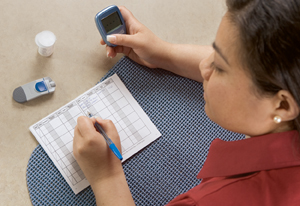How to Check Your Blood Sugar
How to Check Your Blood Sugar
Keeping track of how much sugar (glucose) is in your blood is an important part of self-care when you have diabetes. This is also called self-monitoring of blood glucose (SMBG). To make sure your glucose and insulin are in balance, check your blood sugar as instructed by your healthcare provider. You may need to check your blood glucose levels at certain times every day. Or you may need to check them only a few times a week.
What you need
To check your blood sugar, make sure you have the following:
A small pricking needle (lancing device)
Test strips
A glucose meter
A notebook, chart, or log book and pen or pencil
Using a blood glucose meter
You can check your blood sugar at home, at work, and anywhere else. Your diabetes team will help you choose a blood glucose meter. A meter measures the amount of glucose in a tiny drop of blood. You’ll use a device called a lancet to draw a drop of blood. Put the strip in the meter first. Then touch the test strip to the drop of blood. The meter then gives you a number (reading) that tells you the level of your blood sugar.
Aim for your target range
Your blood sugar should be in your target range—not too high and not too low. A target range is where your blood sugar level is healthiest. Staying in this range as much as possible will help lower your risk for health problems (complications). Your diabetes team will help you figure out the best target range for you. That range depends on many things. They include your age, other health problems, how well your diabetes is controlled, and how long you have had diabetes. In general, target ranges are:
Control of blood glucose (hemoglobin A1c or A1c): generally, 7.0% or less. You will usually have this test at the lab.
Before a meal (preprandial glucose): Between 80 and 130 mg/dL.
One to 2 hours after a meal (postprandial glucose): Less than 180 mg/dL.
Track your readings
Use a notebook, chart, or log book to keep track of your readings. Write down the date, time, and your blood sugar level numbers. This helps you see patterns, such as high blood sugar after eating certain foods. Take your log along when you see your healthcare provider. Your blood glucose levels will help your provider decide if he or she needs to make any changes to your management plan. To check your blood sugar, follow the steps below.
Step 1. Get ready
Wash your hands with soap and warm (not hot) water.
Follow all of the instructions that came with your glucometer. Be sure that your test strips were designed to be used with your meter and are not expired.
Step 2. Draw a drop of blood
Prick the side of your finger with the lancet. Squeeze gently until you get a drop of blood. Squeezing too hard can cause an inaccurate reading.
Put the lancet in a special sharps container. Ask your healthcare team where you can buy one or what you can use to throw away any sharps.
If you are unable to get enough blood, hold your hand at your side and gently shake it.
Step 3. Place the drop on a strip
Wait for the meter to show a message or symbol that it is time to test.
Touch the test strip to the drop of blood.
Be sure to follow the instructions included with meter.
Step 4. Read and record your results
Wait for your meter to show the result.
If you see an error message, recheck using a fresh strip and a fresh drop of blood. Also recheck if the glucose numbers aren't what you expect—too low without symptoms, or too high for no reason.
Write the results in your log book.
Updated:
July 24, 2018
Reviewed By:
Brown, Kim, APRN,Hurd, Robert, MD,Image reviewed by StayWell art team.
